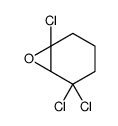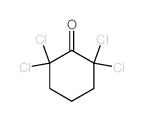71648-20-9
| 英文名 | 2,2,6-trichloro-7-oxabicyclo[4.1.0]heptane |
|---|---|
| 英文别名 |
1,3,3-trichloro-7-oxabicyclo<4.1.0>heptane
EINECS 275-748-6 |
| 密度 | 1.51g/cm3 |
|---|---|
| 沸点 | 270.8ºC at 760 mmHg |
| 分子式 | C6H7Cl3O |
| 分子量 | 201.47800 |
| 闪点 | 115.1ºC |
| 精确质量 | 199.95600 |
| PSA | 12.53000 |
| LogP | 2.67810 |
| 折射率 | 1.543 |
|
Version 1.0
Regulation (EC) No 1907/2006 1 - Product and Company Information Product Name2,6,6-TRICHLORO-1,2-EPOXYCYCLO - 250 MG HEXANE 2 - Hazards Identification SPECIAL INDICATION OF HAZARDS TO HUMANS AND THE ENVIRONMENT Causes burns. Toxic to aquatic organisms, may cause long-term adverse effects in the aquatic environment. 3 - Composition/Information on Ingredients Product NameCAS #EC noAnnex I Index Number 2,6,6-TRICHLORO-1,2-EPOXYCYCLOHEXA 71648-20-9 275-748-6 None NE FormulaC6H7Cl3O 4 - First Aid Measures AFTER INHALATION If inhaled, remove to fresh air. If not breathing give artificial respiration. If breathing is difficult, give oxygen. AFTER SKIN CONTACT In case of skin contact, flush with copious amounts of water for at least 15 minutes. Remove contaminated clothing and shoes. Call a physician. AFTER EYE CONTACT In case of contact with eyes, flush with copious amounts of water for at least 15 minutes. Assure adequate flushing by separating the eyelids with fingers. Call a physician. AFTER INGESTION If swallowed, wash out mouth with water provided person is conscious. Call a physician. Do not induce vomiting. ALDRICHwww.molbase.com 5 - Fire Fighting Measures EXTINGUISHING MEDIA Suitable: Carbon dioxide, dry chemical powder, or appropriate foam. SPECIAL RISKS Specific Hazard(s): Emits toxic fumes under fire conditions. SPECIAL PROTECTIVE EQUIPMENT FOR FIREFIGHTERS Wear self-contained breathing apparatus and protective clothing to prevent contact with skin and eyes. 6 - Accidental Release Measures PERSONAL PRECAUTION PROCEDURES TO BE FOLLOWED IN CASE OF LEAK OR SPILL Evacuate area. PROCEDURE(S) OF PERSONAL PRECAUTION(S) Wear self-contained breathing apparatus, rubber boots, and heavy rubber gloves. METHODS FOR CLEANING UP Cover with dry lime or soda ash, pick up, keep in a closed container, and hold for waste disposal. Ventilate area and wash spill site after material pickup is complete. ADDITIONAL INFORMATION Avoid contact with eyes, skin, and clothing. 7 - Handling and Storage HANDLING Directions for Safe Handling: Do not breathe vapor. Do not get in eyes, on skin, on clothing. Avoid prolonged or repeated exposure. STORAGE Conditions of Storage: Keep tightly closed. 8 - Exposure Controls / Personal Protection ENGINEERING CONTROLS Safety shower and eye bath. Use only in a chemical fume hood. GENERAL HYGIENE MEASURES Wash contaminated clothing before reuse. Discard contaminated shoes. Wash thoroughly after handling. PERSONAL PROTECTIVE EQUIPMENT Respiratory Protection: Use respirators and components tested and approved under appropriate government standards such as NIOSH (US) or CEN (EU). Where risk assessment shows air-purifying respirators are appropriate use a full-face respirator with multi-purpose combination (US) or type ABEK (EN 14387) respirator cartridges as a backup to engineering controls. If the respirator is the sole means of protection, use a full-face supplied air respirator. Hand Protection: Compatible chemical-resistant gloves. Eye Protection: Chemical safety goggles. Special Protective Measures: Faceshield (8-inch minimum). ALDRICHwww.molbase.com 9 - Physical and Chemical Properties AppearancePhysical State: Liquid PropertyValueAt Temperature or Pressure pH N/A BP/BP RangeN/A MP/MP RangeN/A Flash PointN/A FlammabilityN/A Autoignition TempN/A Oxidizing Properties N/A Explosive Properties N/A Explosion LimitsN/A Vapor PressureN/A ViscosityN/A Vapor DensityN/A Saturated Vapor Conc. N/A Evaporation RateN/A Bulk DensityN/A Decomposition Temp.N/A Solvent ContentN/A Water ContentN/A Surface TensionN/A ConductivityN/A Miscellaneous DataN/A SolubilityN/A 10 - Stability and Reactivity STABILITY Stable: Stable. Materials to Avoid: Strong oxidizing agents. HAZARDOUS DECOMPOSITION PRODUCTS Hazardous Decomposition Products: Carbon monoxide, Carbon dioxide, Hydrogen chloride gas. HAZARDOUS POLYMERIZATION Hazardous Polymerization: Will not occur 11 - Toxicological Information SENSITIZATION Sensitization: Possible sensitizer. Skin: Prolonged or repeated exposure may cause allergic reactions in certain sensitive individuals. The preceding data, or interpretation of data, was determined using Quantitative Structure Activity Relationship (QSAR) modeling. SIGNS AND SYMPTOMS OF EXPOSURE Symptoms of exposure may include burning sensation, coughing, wheezing, laryngitis, shortness of breath, headache, nausea, and vomiting. Material is extremely destructive to tissue of the mucous membranes and upper respiratory tract, eyes, and skin. Inhalation may result in spasm, inflammation and edema of the larynxand bronchi, chemical pneumonitis, and pulmonary edema. ALDRICHwww.molbase.com ROUTE OF EXPOSURE Skin Contact: Causes burns. Skin Absorption: May be harmful if absorbed through the skin. Eye Contact: Causes burns. Inhalation: May be harmful if inhaled. Material is extremely destructive to the tissue of the mucous membranes and upper respiratory tract. Ingestion: May be harmful if swallowed. 12 - Ecological Information No data available. 13 - Disposal Considerations SUBSTANCE DISPOSAL Contact a licensed professional waste disposal service to dispose of this material. Dissolve or mix the material with a combustible solvent and burn in a chemical incinerator equipped with an afterburner and scrubber. Observe all federal, state, and local environmental regulations. 14 - Transport Information RID/ADR UN#: 1760 Class: 8 PG: III Proper Shipping Name: Corrosive liquid, n.o.s. IMDG UN#: 1760 Class: 8 PG: III Proper Shipping Name: Corrosive liquid, n.o.s. Marine Pollutant: No Severe Marine Pollutant: No Technical Name: Required IATA UN#: 1760 Class: 8 PG: III Proper Shipping Name: Corrosive liquid, n.o.s. Inhalation Packing Group I: No Technical Name: Required 15 - Regulatory Information CLASSIFICATION AND LABELING ACCORDING TO EU DIRECTIVES INDICATION OF DANGER: C-N Corrosive. Dangerous for the environment. R-PHRASES: 34-51/53 Causes burns. Toxic to aquatic organisms, may cause long-term adverse effects in the aquatic environment. S-PHRASES: 26-36/37/39-45 In case of contact with eyes, rinse immediately with plenty of water and seek medical advice. Wear suitable protective clothing, gloves, and eye/face protection. In case of accident or if you feel unwell, seek medical advice immediately (show ALDRICHwww.molbase.com the label where possible). 16 - Other Information WARRANTY The above information is believed to be correct but does not purport to be all inclusive and shall be used only as a guide. The information in this document is based on the present state of our knowledge and is applicable to the product with regard to appropriate safety precautions. It does not represent any guarantee of the properties of the product. Inc., shall not be held liable for any damage resulting from handling or from contact with the above product. See reverse side of invoice or packing slip for additional terms and conditions of sale. Copyright 2010 Co. License granted to make unlimitedpaper copies for internal use only. DISCLAIMER For R&D use only. Not for drug, household or other uses. ALDRICHwww.molbase.com |
|
~98% 
71648-20-9 |
| 文献:Duhamel, Pierre; Leblond, Bertrand; Poirier, Jean-Marie Journal of the Chemical Society, Chemical Communications, 1993 , # 5 p. 476 - 477 |
|
~% 
71648-20-9 |
| 文献:Duhamel, Pierre; Leblond, Bertrand; Bidois-Sery, Laure; Poirier, Jean-Marie Journal of the Chemical Society, Perkin Transactions 1: Organic and Bio-Organic Chemistry (1972-1999), 1994 , # 16 p. 2265 - 2272 |


